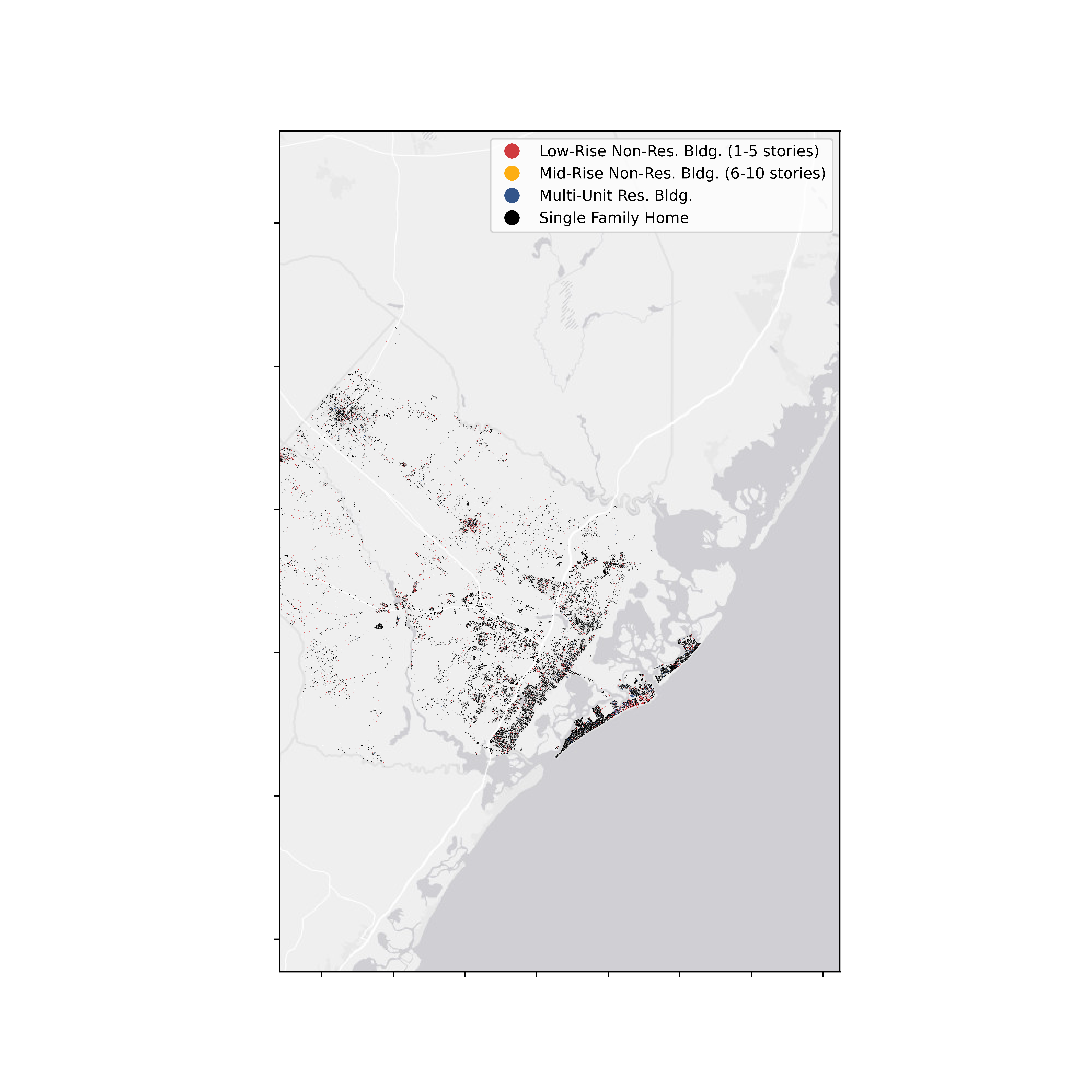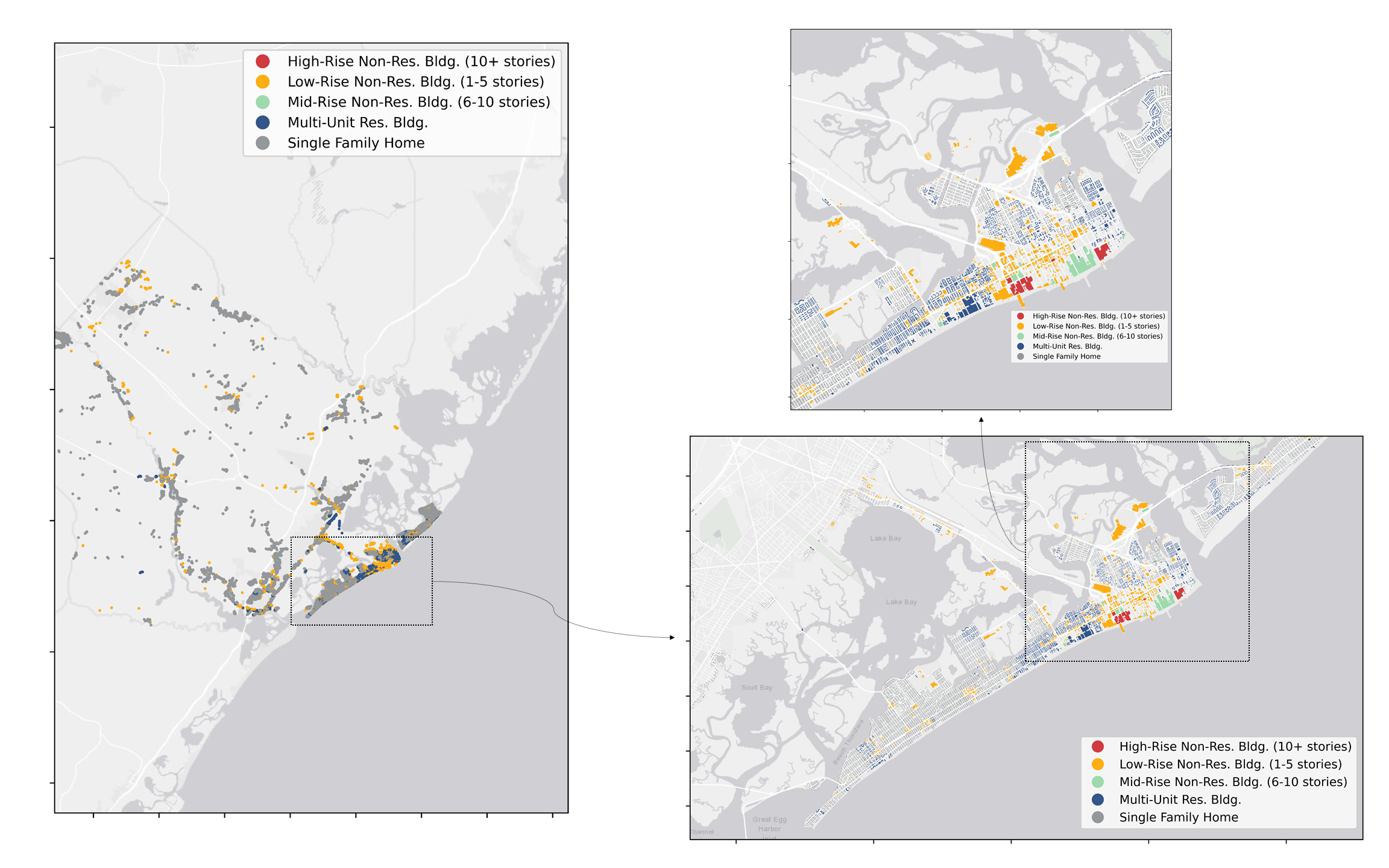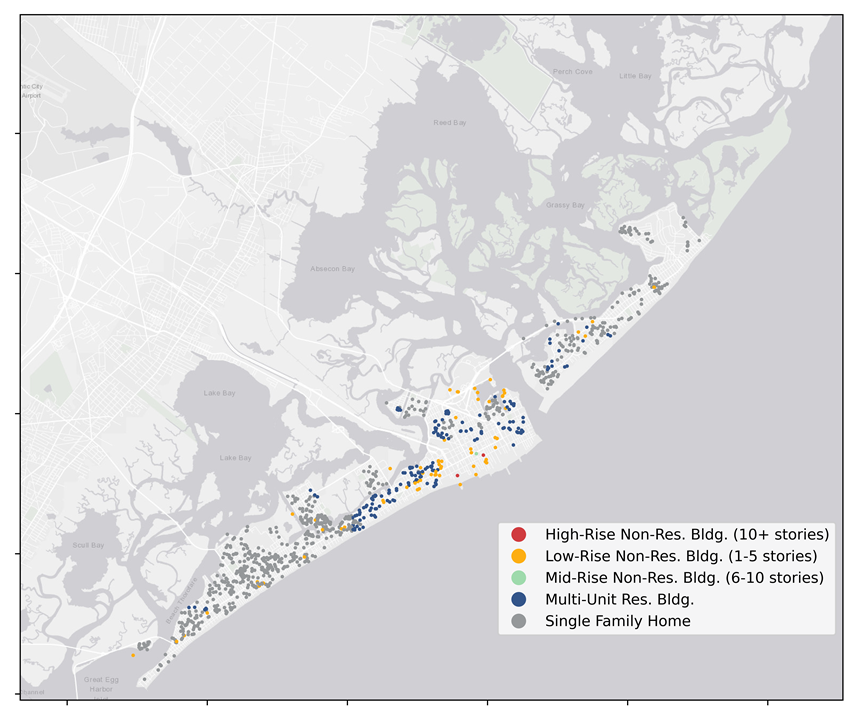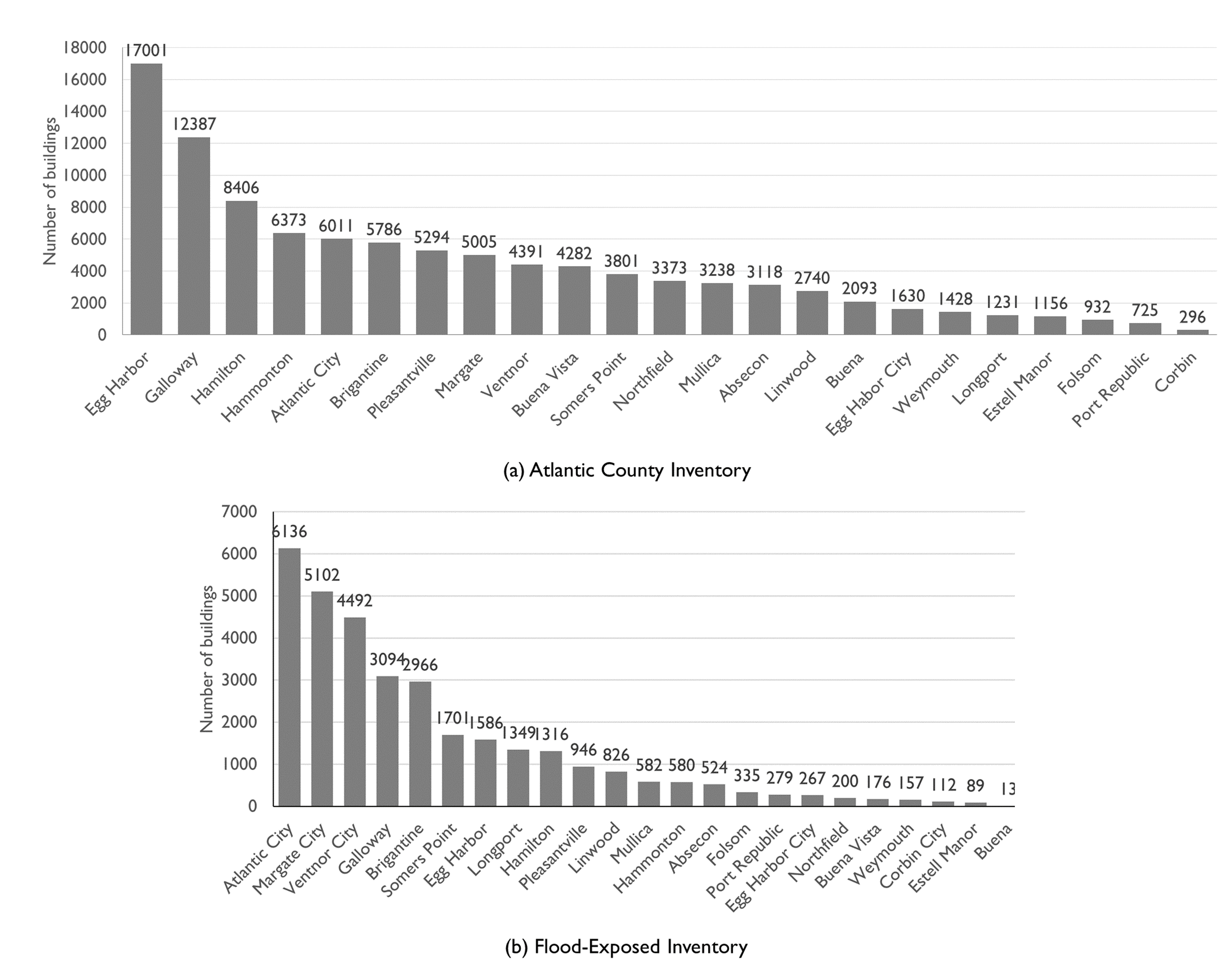2.1. Overview
This testbed for regional hurricane risk assessment of Atlantic County, New Jersey under multiple hazards adopts an approach consistent with that developed for earthquake hazards. Its intent is to demonstrate the computational scaffolding upon which community developers can progressively contribute refinements that increase the fidelity and capacities of the backend regional resilience assessment workflow. This documentation specifically demonstrates the process of: (1) asset description, (2) hazard characterization, (3) asset representation, (4) damage and loss modeling for the Atlantic County inventory. This inventory is partitioned into two different versions to provide users with greater flexibility in balancing computational demands with their research interests. Sample results are presented to verify the workflow and demonstrate its usage.
2.1.1. Rationale
This testbed builds upon existing relationships between SimCenter personnel and the State of New Jersey through the NJcoast project ([KijewskiCorrea19], [NJCoast20]), which made available various inventory data and high-fidelity characterizations of wind, storm surge, and wave action. Notably, the State of New Jersey has made sizable investments in open data and resilience planning tools in recent years, enabling a demonstration of how to leverage these data for inventory development.
The selection of Atlantic County, NJ, and specifically Atlantic City and its surrounding municipalities, offers a well-defined metro area with a blend of low-rise commercial (1-3 stories), industrial, high-rise hotels/casinos (over 20 stories), and single/multi-family residences. Thus, a single testbed encompasses two extremes in building typologies with known vulnerabilities to wind: wood frame single-family homes and tall flexible structures more susceptible to dynamic wind effects. From the perspective of hazard exposure, this region is also characterized by beachfront communities exposed to storm surge and breaking waves on the ocean-facing coastline and back bay and riverine flooding. This blend of residential communities and more urban central business districts frequented by tourists moreover enables evaluation of resilience across different communities with differing profiles. As the State of New Jersey has actually taken control of Atlantic City to reimagine its role as an economic hub for the state, this testbed can help inform how future planning decisions should consider hurricane risk.
2.1.2. Capabilities and Supported Hazards
The testbed supports the transition from census-block-level loss projections to asset-level projections that assess the damage to individual buildings under multiple hurricane-induced hazards: wind and storm surge. Water penetration due to the breach of building envelopes and/or wind-borne debris impact are also captured in the damage and loss modeling, though the physics of these phenomena themselves are not explicitly modeled. Similarly, other hydrologic hazards related to accumulated rainfall, inland flooding, overland flow, and riverine flooding, are not captured. Supported building classes include residential, commercial and industrial construction, critical facilities, and manufactured homes, constructed of wood, steel, reinforced concrete, and masonry. The adoption of HAZUS loss estimation frameworks constrains the current testbed to buildings 6 stories and under and only the building classes currently supported by HAZUS ([FEMA18a], [FEMA18b]).
2.1.3. Current Implementation
For the initial implementation of the backend workflow, the asset description adopts an augmented parcel approach that enriches tax assessor data. High-fidelity computational simulations are employed to simulate wind and surge hazards, characterized by two intensity measures: the Peak Wind Speed (PWS) and Peak Water Depth (PWD), for specific scenarios. In lieu of a structural analysis model, assets are assigned attributes associated with various HAZUS-consistent building classifications. The adoption of the HAZUS damage and loss assessment methodology for hurricanes and floods thus enables these intensity measures to be related to probabilities of damage and loss, based on the building class and assigned attributes.
2.1.4. Available Inventories
Two different building inventories have been developed for the Atlantic County testbed and can be accessed on DesignSafe.
Atlantic County Inventory: A full inventory of 100,721 buildings in the 23 municipalities of Atlantic County, described based on a variety of data sources (Fig. 2.1.4.1). The buildings in this inventory are exposed to either wind only or the combination of wind and floodplain hazards.

Fig. 2.1.4.1 Geospatial visualization of subclasses of buildings in the Atlantic County Inventory.
Flood-Exposed Inventory: This subset of the Atlantic County inventory includes 32,828 buildings in FEMA Special Flood Hazard Areas (SFHAs) (Fig. 2.1.4.2), as identified by the New Jersey Department of Environmental Protection (NJDEP). This includes all buildings in (or within a 200-foot buffer of) the 1% annual chance (AC) floodplain, as defined by FEMA Flood Insurance Rate Maps (FIRMs). The buildings in this inventory are exposed to the combination of wind and floodplain hazards, and include some of the most populated municipalities in the county: Atlantic City, Margate City, and Ventnor City, which contribute to about 50% of the entire building inventory in Atlantic County.

Fig. 2.1.4.2 Geospatial visualization of subclasses of buildings in the Flood-Exposed Inventory.
Exploration Inventory: A subset of 1000 buildings drawn from the Flood-Exposed Inventory is intended to provide a less computationally demanding implementation for new users or for those wishing to test the development of new contributions to the workflow (Fig. 2.1.4.3). This inventory encompasses the five coastal municipalities experiencing the most damage under the synthetic storm scenario described later in Synthetic Storm Scenario. From each of these municipalities, properties are randomly sampled, proportional to the total number of buildings in that municipality and ensuring that the distribution of construction material of buildings in the sample is representative of the underlying distribution for the full population. The buildings in this inventory are exposed to the combination of wind and floodplain hazards.

Fig. 2.1.4.3 Geospatial visualization of subclasses of buildings in the Flood-Exposed Inventory.
The following figures summarize the characteristics of these inventories, including distribution by municipality (Fig. 2.1.4.4), by year built (Fig. 2.1.4.5), by occupancy (Fig. 2.1.4.6), by number of stories (Fig. 2.1.4.7), and by primary construction material (Fig. 2.1.4.8). Notably, these inventories are typified by older vintages of construction (79% of Atlantic County buildings were constructed before 1980), with a dominance of low-rise (1-2 stories), residential, wood frame construction (approximately 90% of Atlantic County buildings). Steel and reinforced concrete construction is more prevalent in downtown Atlantic City.

Fig. 2.1.4.4 Distribution of the number of buildings by municipality.

Fig. 2.1.4.5 Distribution of buildings by year built.

Fig. 2.1.4.6 Distribution of buildings by occupancy type.

Fig. 2.1.4.7 Distribution of buildings by total number of stories.

Fig. 2.1.4.8 Distribution of primary construction material types.
FEMA (2018), HAZUS – Multi-hazard Loss Estimation Methodology 2.1, Hurricane Model Technical Manual, Federal Emergency Management Agency, Washington D.C., 718p.
FEMA (2018), HAZUS – Multi-hazard Loss Estimation Methodology 2.1, Flood Model Technical Manual, Federal Emergency Management Agency, Washington D.C., 569p.
Kijewski-Correa, T., Taflanidis, A., Vardeman, C., Sweet, J., Zhang, J., Snaiki, R., … & Kennedy, A. (2020). Geospatial environments for hurricane risk assessment: applications to situational awareness and resilience planning in New Jersey. Frontiers in Built Environment, 6, 549106.
NJ Coast (2020), Storm Hazard Projection Tool, NJ Coast, https://njcoast.us/resources-shp/